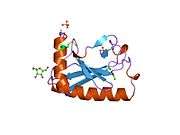FHIT
| View/Edit Human | View/Edit Mouse |
Bis(5'-adenosyl)-triphosphatase also known as fragile histidine triad protein (FHIT) is an enzyme that in humans is encoded by the FHIT gene.[4][5]
Function
FHIT is also known as human accelerated region 10. It may, therefore, have played a key role in differentiating humans from apes.[6]
This gene, a member of the histidine triad gene family, encodes a diadenosine P1,P3-bis(5'-adenosyl)-triphosphate adenylohydrolase involved in purine metabolism. The gene encompasses the common fragile site FRA3B on chromosome 3, where carcinogen-induced damage can lead to translocations and aberrant transcripts of this gene. In fact, aberrant transcripts from this gene have been found in about half of all esophageal, stomach, and colon carcinomas.[7]
Though the exact molecular function of FHIT is still partially unclear, the gene works as a tumor suppressor as it has been demonstrated in animal studies.[8][9][10] Furthermore FHIT has been shown to synergize with VHL, another tumor suppressor, in protecting against chemically - induced lung cancer.[11]
FHIT also acts as a tumor suppressor of HER2/neu driven breast cancer.[12]
Interactions
FHIT has been shown to interact with UBE2I.[13]
References
- ↑ "Diseases that are genetically associated with FHIT view/edit references on wikidata".
- ↑ "Human PubMed Reference:".
- ↑ "Mouse PubMed Reference:".
- ↑ Ohta M, Inoue H, Cotticelli MG, Kastury K, Baffa R, Palazzo J, Siprashvili Z, Mori M, McCue P, Druck T, Croce CM, Huebner K (Apr 1996). "The FHIT gene, spanning the chromosome 3p14.2 fragile site and renal carcinoma-associated t(3;8) breakpoint, is abnormal in digestive tract cancers". Cell. 84 (4): 587–97. doi:10.1016/S0092-8674(00)81034-X. PMID 8598045.
- ↑ Pekarsky Y, Campiglio M, Siprashvili Z, Druck T, Sedkov Y, Tillib S, Draganescu A, Wermuth P, Rothman JH, Huebner K, Buchberg AM, Mazo A, Brenner C, Croce CM (Aug 1998). "Nitrilase and Fhit homologs are encoded as fusion proteins in Drosophila melanogaster and Caenorhabditis elegans". Proc. Natl. Acad. Sci. U.S.A. 95 (15): 8744–9. doi:10.1073/pnas.95.15.8744. PMC 21147
 . PMID 9671749.
. PMID 9671749. - ↑ Pollard KS, Salama SR, Lambert N, Lambot MA, Coppens S, Pedersen JS, Katzman S, King B, Onodera C, Siepel A, Kern AD, Dehay C, Igel H, Ares M, Vanderhaeghen P, Haussler D (2006-08-16). "An RNA gene expressed during cortical development evolved rapidly in humans". Nature. 443 (7108): 167–72. doi:10.1038/nature05113. PMID 16915236. supplement
- ↑ "Entrez Gene: FHIT fragile histidine triad gene".
- ↑ Fong LY, Fidanza V, Zanesi N, Lock LF, Siracusa LD, Mancini R, Siprashvili Z, Ottey M, Martin SE, Druck T, McCue PA, Croce CM, Huebner K (April 2000). "Muir-Torre-like syndrome in Fhit-deficient mice". Proc. Natl. Acad. Sci. U.S.A. 97 (9): 4742–7. doi:10.1073/pnas.080063497. PMC 18303
 . PMID 10758156.
. PMID 10758156. - ↑ Zanesi N, Fidanza V, Fong LY, Mancini R, Druck T, Valtieri M, Rüdiger T, McCue PA, Croce CM, Huebner K (August 2001). "The tumor spectrum in FHIT-deficient mice". Proc. Natl. Acad. Sci. U.S.A. 98 (18): 10250–5. doi:10.1073/pnas.191345898. PMC 56947
 . PMID 11517343.
. PMID 11517343. - ↑ Zanesi N, Pekarsky Y, Croce CM (December 2005). "A mouse model of the fragile gene FHIT: From carcinogenesis to gene therapy and cancer prevention". Mutat. Res. 591 (1-2): 103–9. doi:10.1016/j.mrfmmm.2005.05.016. PMID 16085127.
- ↑ Zanesi N, Mancini R, Sevignani C, Vecchione A, Kaou M, Valtieri M, Calin GA, Pekarsky Y, Gnarra JR, Croce CM, Huebner K (August 2005). "Lung cancer susceptibility in Fhit-deficient mice is increased by Vhl haploinsufficiency". Cancer Res. 65 (15): 6576–82. doi:10.1158/0008-5472.CAN-05-1128. PMID 16061637.
- ↑ Bianchi F, Tagliabue E, Ménard S, Campiglio M (March 2007). "Fhit expression protects against HER2-driven breast tumor development: unraveling the molecular interconnections". Cell Cycle. 6 (6): 643–6. doi:10.4161/cc.6.6.4033. PMID 17374991.
- ↑ Shi Y, Zou M, Farid NR, Paterson MC (December 2000). "Association of FHIT (fragile histidine triad), a candidate tumour suppressor gene, with the ubiquitin-conjugating enzyme hUBC9". Biochem. J. 352 Pt 2 (2): 443–8. doi:10.1042/0264-6021:3520443. PMC 1221476
 . PMID 11085938.
. PMID 11085938.









